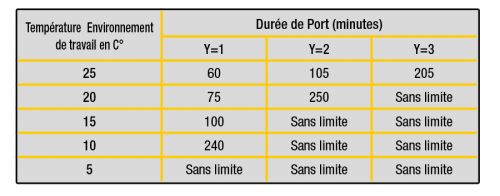PPE Risk Categories
NEW EU 2016/425 REGULATION
Definition of PPE (Personal Protective Equipment) : All equipment (including clothing affording protection against the weather) which is intended to be worn or held by a person at work and which protects the user against one or more risks to their health or safety.
CATEGORY I
This category includes exclusively the following minimal risks: superficial mechanical injury, contact with cleaning materials of weak action or prolonged contact with water, contact with hot surfaces not exceeding 50 °C, damage to the eyes due to exposure to sunlight, atmospheric conditions that are not of an extreme nature.
CATEGORY II
Category II includes risks other those listed in Categories I and III.
CATEGORY III
Category III includes exclusively the risks that may cause very serious consequences such as death or irreversible damage to health relating to the following: substances and mixtures which are hazardous to health, atmospheres with oxygen deficiency, harmful biological agents, ionising radiation, high-temperature environments the effects of which are comparable to those of an air temperature of at least 100 °C, lowtemperature environments the effects of which are comparable to those of an air temperature of –50 °C or less, falling from a height, electric shock and live working, drowning, cuts by hand-held chainsaws, high-pressure jets, bullet wounds or knife stabs, harmful noise.
 The CE marking is a visual symbol that indicates that the clothing meets all the legal safety requirements set out in the new 2016/425 regulation.
The CE marking is a visual symbol that indicates that the clothing meets all the legal safety requirements set out in the new 2016/425 regulation.
PROTECTION STANDARD
AGAINST THE WEATHER FOG AND GROUND HUMIDITY
EN 343 : 2003 + A1 : 2007

Water resistance (X) of fabric/seams is measured using the water column test. The class 3 denoting the highest level.
Breathability (Y) : The higher the RET is, the less breathable the fabric is.
USER INSTRUCTIONS
The garment should be closed properly to ensure maximum protective performance.
Maximum recommended wearing time depending of water vapour resistance Class :

BUOYANCY AID STANDARDS?
NF EN ISO 12402-5 November 2006
 Personal flotation devices - Part 5: Buoyancy aids (level 50) - Safety requirements
Personal flotation devices - Part 5: Buoyancy aids (level 50) - Safety requirements
This specifies the safety requirements for buoyancy aids with a buoyancy of not less than 50 N used in sheltered aters with help and rescue close at hand. It applies to buoyancy aids used by adults or children.
NF EN ISO 12402-3/A1 July 2010
 Personal flotation devices - Part 3: lifejackets, performance level 150 - Safety requirements - Amendment 1
Personal flotation devices - Part 3: lifejackets, performance level 150 - Safety requirements - Amendment 1
This specifies the safety requirements for performance level 150 N lifejackets. This applies to lifejackets used by adults and children.
NF EN ISO 12402-2/A1 July 2010
 Personal flotation devices - Part 2: lifejackets, performance level 275 - Safety requirements - Amendment 1
Personal flotation devices - Part 2: lifejackets, performance level 275 - Safety requirements - Amendment 1
This specifies the safety requirements for performance level 275 N lifejackets.This applies to lifejackets used by adults and children intended for use offshore, in extreme conditions.
SOLAS = Safety Of Life At Sea
 Convention that sets minimum safety standards in the construction, equipment and operation of merchant ships.
Convention that sets minimum safety standards in the construction, equipment and operation of merchant ships.
Our Guy Cotten products have been tested by FLEETWOOD TEST HOUSE, FLEETWOOD NAUTICAL CAMPUS
BROADWATER, FLEETWOOD, LANCASHIRE, FY7 8JZ - Notified body N°0514
Phone : (01253) 779123 - Email : ftl@blackpool.ac.uk
HIGH-VISIBILITY PROTECTION STANDARD
EN ISO 20471 : A1 : 2016
The class (X) is based on the minimum required surface (m²) of visible materials on the garment. Measurements are made on the smallest size.?

USER INSTRUCTIONS
The use of a high-visibility garment does not guarantee that the user will be visible in all circumstances and conditions. It improves conspicuity when there is a high risk of not being seen. It must not be covered by other clothing or equipment.
Any markings should maintain the area of the visible materials to comply withthe standard. A suit consisting of jacket and trousers may be listed in a higher category if it complies with the minimum visible area requirement (cf. table).
Please contact us if you need further information.
SPECIAL INSTRUCTIONS
The maximal washing cycles number indicated is not the only factor linked to the life expectancy of the garment. Its life also depends on the conditions of use, care and storage conditions. The garment does not provide an optimal protection if the material is worn or damaged. The garment may only be repaired with materials and threads that meet the requirements of the standard for the garment.
Cleaning and maintenance instructions
Our Guy Cotten products have been tested by CENTEXBEL
Technologiepark 7 BE – 9052 ZWIJNAARDE - BELGIUM
Phone +32 9 243 46 98 / Fax + 32 9 243 46 98
www.centexbel.be - Notified body 0493
PROTECTION STANDARDS AGAINST CHEMICAL PRODUCTS

There are six types of garments that provide protection against chemical products :
NF EN 943-1 and NF EN 943-2
Type 1: Ventilated and non-ventilated “gas-tight” chemical protective suit with breathing air supply.
NF EN 943-1
Type 2 : Ventilated and non-ventilated “non-gas tight” chemical protective suit with compressed air breathing supply.
NF EN 14605+A1
Type 3 : Liquid-tight chemical protective clothing – jet test.
NF EN 14605+A1
Type 4 : Spray-tight liquid protective clothing.
NF EN ISO 13982-1/A1
Type 5 : Clothing offering protection against chemicals in the form of solid particles.
NF EN 13034+A1
Type 6 : Clothing designed to offer protection against potential exposure to small quantities of spray or accidental low olume splashes of low risk chemicals.
PROTECTION STANDARD AGAINST PHYTOSANITARY RISKS?

NF EN ISO 27065-NOVEMBER 2017
"Protective clothing – Performance requirements for protective clothing worn by operators applying pesticides and for workers exposed to these pesticides.”
